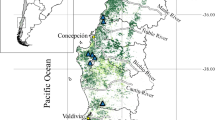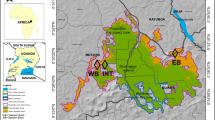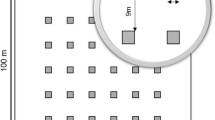Abstract
Zawita natural forest has recently has been subject to mass recreational activities during spring that have denuded large areas of the forest. It was thus essential to assess regeneration before designing optimizing strategies. To this end, we studied the overstory canopy and microhabitat conditions for recruitment of Pinus brutia Ten in 10 plots (20 × 25 m) on the southern aspects where the Zawita natural forest is still present. In total, 1540 regenerating P. brutia were recorded, 854 seedlings, 597 saplings, and 89 trees. Seedlings and saplings were more frequent beyond the canopy than under the canopy of the parent trees. Regeneration requirements differed between seedlings and saplings. The probability of the occurrence of seedlings was negatively correlated with increasing litter depth and increasing soil compaction. The density of saplings only showed a positive significant correlation with increasing slope. The nearest neighbor index showed a trend toward a positive spatial association between understory shrubs with their neighboring seedlings at a mean distance of 1.6 m. Overall, the study highlighted the requirements for seedling regeneration as a relatively open canopy cover, a light understory litter layer, and non-compacted soils. These results are a step towards designing effective management and restoration programs.





Similar content being viewed by others
References
Adili B, El Aouni MH, Balandier P (2013) Unraveling the influence of light, litter and understorey vegetation on Pinus pinea natural regeneration. Forestry 86:297–304
Ali NS, Ali OO, Esmail AO (2016) Comparison between some soil chemical properties and some nutrients in trees at zawita and hijran forest. Agric Vet Sci 19(1):701–712
Ampoorter E, Frenne PD, Hermy M, Verheyen K (2011) Effects of soil compaction on growth and survival of tree saplings: a meta-analysis. Basic Appl Ecol 12(5):394–402
Boydak M (2004) Silvicultural characteristics and natural regeneration of Pinus brutia Ten.: a review. Plant Ecol 171(1–2):153–163
Bulmer CE, Simpson DG (2005) Soil compaction and water content as factors affecting the growth of lodgepole pine seedlings on sandy clay loam soil. Can J Soil Sci 85:667–679
Caccia FD, Ballaré CL (1998) Effects of tree cover, understory vegetation, and litter on regeneration of Douglas-fir (Pseudotsug amanziessii) in south-western Argentina. Can J Soil Sci 28:683–692
Clark PJ, Evans FC (1954) Distance to nearest neighbor as a measure of spatial relationships in populations. Ecology 35(4):445–453
Corns IGW (1988) Compaction by forestry equipment and effects on coniferous seedling growth on four soils in the Alberta foothills. Can J For Res 18(1):75–84
Delerue F, Gonzalez M, Michalet R, Pellerin S, Augusto L (2015) Weak evidence of regeneration habitat but strong evidence of regeneration niche for a leguminous shrub. PLoS ONE. https://doi.org/10.1371/journal.pone.0130886
Dzwonko Z, Gawronski S (2002) Effect of litter removal on species richness and acidification of a mixed oak-pine woodland. Biol Conserv 106:389–398
Ehlers W, Popke V, Hesse F, Bohm W (1983) Penetration resistance and root growth of oats in tilled and untilled loam soil. Soil Tillage Res 3(3):261–275
Facelli JM, Pickett STA (1991) Plant litter: its dynamics and effects on plant community structure. Bot Rev 57(1):1–32
Fady B, Fineschi S, Vendramin GG (2004) EUFORGEN Technical Guidelines for genetic conservation and use for Italian stone pine (Pinus pinea). International Plant Genetic Resources Institute, Rome
Fernandes PM, Vega JA, Jimenez E, Rigolot E (2008) Fire resistance of European pines. For Ecol Manag 256:246–255
Fernandez C, Voiriot S, Mévy JP, Bruno V, Ormeno E, Dupouyet S, Bousquet-Mélou A (2008) Regeneration failure of Pinus halepensis Mill.: the role of autotoxicity and some abiotic environmental parameters. For Ecol Manag 255:2928–2936
Froehlich HA, Miles MD, Robbins RW (1986) Growth of young Pinus ponderosa and Pinus contorta on compacted soils in central Washington. For Ecol Manag 15:285–294
Ganatsas P, Tsakaldimi M (2007) Effect of light conditions and salinity on germination behaviour and early growth of umbrella pine (Pinus pinea L.) seed. J Hort Sci Biotechnol 82:605–610
García D, Zamora R, Hódar JA, Gómez JM, Castro J (2000) Yew (Taxus baccata L.) regeneration is facilitated by fleshy-fruited shrubs in Mediterranean environments. Biol Conserv 95:31–38
García LV, Maltez-Mouro S, Pérez-Ramos IM, Marañón T, Freitas H (2006) Counteracting gradients of light and soil nutrients in theunderstorey of Mediterranean oak forests. Web Ecol 6:67–74
Gaudio N, Balandier P, Philippe G, Dumas Y, Jean F, Ginisty C (2011) Light-mediated influence of three understorey species (Calluna vulgaris, Pteridiumaquilinum, Moliniacaerulea) on the growth of Pinus sylvestris seedlings. Eur J For Res 130(1):77–89
Ghosh S, Zhu K, Gelfand AE, Clark JS (2016) Joint modeling of climate niches for adult and juvenile trees. J Agric Biol Environ Stat 21(1):111–130
Gomez A, Powers RF, Singer MJ, Howarth WR (2002) Soil compaction effects on growth of young ponderosa pine following litter removal in California’s Sierra Nevada. Soil Sci Soc Am J 66:1334–1343
Gómez-Aparicio L (2008) Spatial patterns of recruitment in Mediterranean plant species: linking the fate of seeds, seedlings and saplings in heterogeneous landscapes at different scales. J Ecol 96:1128–1140
Gómez-Aparicio L, Zamora R, Castro J, Hódar JA (2008) Facilitation of tree saplings by nurse plants: microhabitat amelioration or protection against herbivores? J Veg Sci 19:161–172
Granda E, Escudero A, de la Cruz M, Valladares F (2012) Juvenile-adult tree associations in a continental Mediterranean ecosystem: no evidence for sustained and general facilitation at increased aridity. J Veg Sci 23:164–175
Ibáñez I, Schupp EW (2002) Effects of litter, soil surface conditions, and microhabitat on Cerocarpus ledifolius Nutt. seedling emergence and establishment. J Arid Env 52:209–221
Kabzems R, Haeussler S (2005) Soil properties, aspen and white spruce responses 5 years after organic mater removal and compaction treatments. Can J For Res 35:2045–2055
Kozlowski TT (1999) Soil compaction and growth of woody plants. Scand J For Res 14:596–619
Kozlowski TT (2002) Physiological ecology of natural regeneration of harvested and disturbed forest stands: implications for forest management. For Ecol Manag 158:195–221
Leverkus AB, Rey Benayas JM, Castro J (2016) Shifting demographic conflicts across recruitment cohorts in a dynamic post-disturbance landscape. Ecol 97:2628–2639
Marchi A, Paletto A (2010) Relationship between forest canopy and natural regeneration in the subalpine spruce-larch forest (north-east Italy). Folia Forestalia Polonica. Series A. Forestry 52(1):3–12
Miller RE, Scott W, Hazard JW (1996) Soil compaction and conifer growth after tractor yarding at three coastal Washington locations. Can J For Res 26(2):225–236
Muhamed H, Maalouf J-P, Michalet R (2013) Summer drought and canopy opening increase the strength of the oak seedlings–shrub spatial association. Ann For Sci 70:345–355
Muhamed H, Lingua E, Maalouf J-P, Michalet R (2015) Shrub-oak seedling spatial associations change in response to the functional composition of neighbouring shrubs in coastal dune forest communities. Ann For Sci 72:231–241
Özdemir Ô (1977) Studies on the possibilities of natural regeneration of Pinus brutia Ten. in Antalya region (in Turkish). Review of the Faculty of Forestry, University of Istanbul Á/2:(Abstract)
Quero JL, Gómez-Aparicio L, Zamora R, Maestre FT (2008) Shifts in the regeneration niche of an endangered tree (Acer opalus ssp. granatense) during ontogeny: using an ecological concept for application. Basic Appl Ecol 9:635–644
Sanchez FG, Scott DA, Ludovici KH (2006) Negligible effects of severe organic matter removal and soil compaction on loblolly pine growth over 10 years. For Ecol Manag 227:145–154
Sands R, Bowen GD (1978) Compaction of sandy soils in radiata pine forests. II. Effects of compaction on root configuration and growth of radiata pine seedlings. Aust For Res 8:163–170
Shahbaz S (2007) Pinales: Spirez Press and Publication, colored. Duhok, Kurdistan Region of Iraq, 188 pp
Thanos CA, Doussi M (2000) Post-fire regeneration of Pinus brutia forests. In: Ne’eman G, Trabaud L (eds) Ecology, biogeography and management of Pinus halepensis and P. brutia forest ecosystems in the Meditenanean basin. Backhuys Publisher, Leiden, pp 291–301
Thanos CA, Skordilis A (1987) The effect of light, temperature and osmotic stress on the germination of Pinus halepensis and Pinus brutia seeds. Seed Sci Technol 15:163–174
Titus JH, del Moral R (1998) Seedling establishment in different microsites on Mount St. Helens, Washington, USA. Plant Ecol 134:13–26
Wangchuk K (2007) Natural regeneration ecology of mixed conifer forests in Western Bhutan. M.Sc.thesis, University of Applied Life Sciences, Vienna, Austria, 79 pp
Zhu JJ, Takeshi M, Lee FQ, Yutaka G (2003) Effect of gap size created by thinning on seedling emergency, survival and establishment in a coastal pine forest. For Ecol Manag 182:339–354
Acknowledgements
We thank the Directorate of the Forestry and Rangelands of Duhok for permission to work in Zawita forest and for their assistance in the field.
Author information
Authors and Affiliations
Corresponding author
Additional information
Project funding: The work was supported by the Agriculture College of Duhok University.
The online version is available at http://www.springerlink.com
Corresponding editor: Tao Xu.
Electronic supplementary material
Below is the link to the electronic supplementary material.
Rights and permissions
About this article
Cite this article
Muhamed, H., Youssef, S., Mustafa, A. et al. Natural regeneration of Pinus brutia Ten. in a recreational public forest in Zawita-Kurdistan region, Iraq. J. For. Res. 30, 1849–1857 (2019). https://doi.org/10.1007/s11676-018-0739-x
Received:
Accepted:
Published:
Issue Date:
DOI: https://doi.org/10.1007/s11676-018-0739-x




